 There’s some good news and some bad news about the UK economy. The good news is that there are signs that the recovery is gathering momentum; the ‘green shoots’ are growing bigger. The bad news is that it’s the ‘wrong type of growth’!
There’s some good news and some bad news about the UK economy. The good news is that there are signs that the recovery is gathering momentum; the ‘green shoots’ are growing bigger. The bad news is that it’s the ‘wrong type of growth’!
One of the main underlying problems of the 2008 financial crisis was that household debt had been increasing to unsustainable levels, egged on by banks only too willing to lend, whether as personal loans, on credit cards or through mortgages. When the recession hit, many people sought to reduce their debts by cutting back on spending. This further fuelled the recession.
What the government and most economists hoped was that there would be some rebalancing of the economy, with less reliance on consumer spending to drive economic growth. Instead it was hoped that growth would be driven by a rise in investment and exports. Indeed, the 25% depreciation of sterling exchange between 2007 and 2009 was seen as a major advantage as this would boost the demand for exports and encourage firms to invest in the export sector.
But things haven’t turned out the way people hoped. The recession (or lack of growth) has been much deeper and more prolonged than previous downturns in the economy. Today, real GDP per head is more than 7% below the level in 2007 and many people have seen much bigger declines in their living standards.
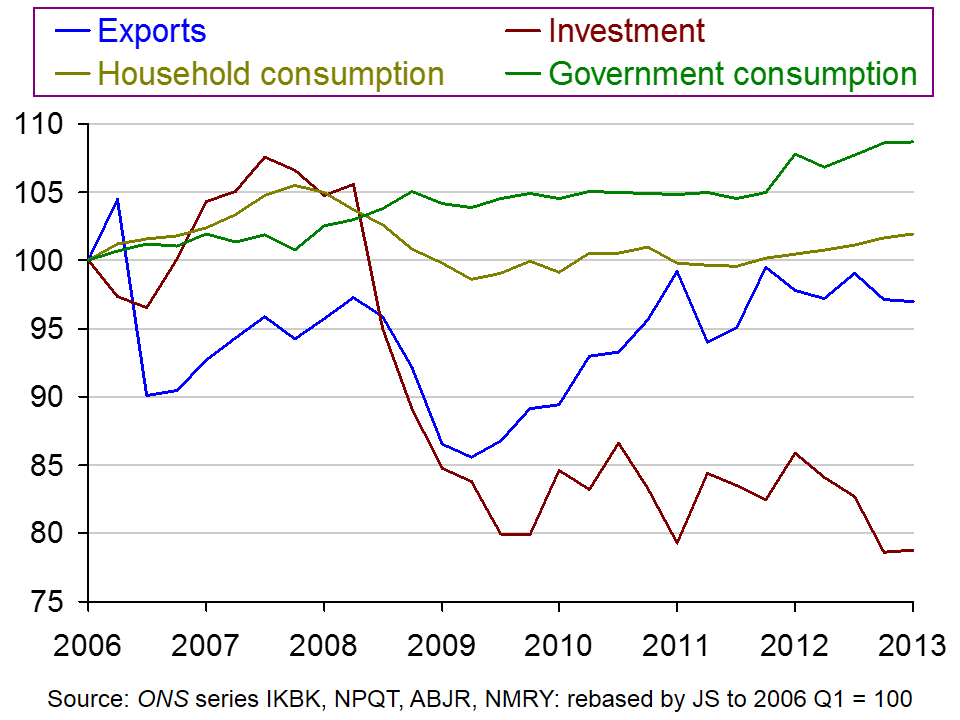 But also, despite the austerity policies, the economy has not been ‘rebalanced’ towards exports and investment. Exports are 3% lower than in 2006 (although they did grow between 2009 Q2 and 2011 Q1, but have since stagnated). And investment is 27% lower than in 2006. Household consumption, however, has grown by about 2% and general government consumption by around 9% since 2006. The chart shows the figures, based on 2006 Q1 = 100.
But also, despite the austerity policies, the economy has not been ‘rebalanced’ towards exports and investment. Exports are 3% lower than in 2006 (although they did grow between 2009 Q2 and 2011 Q1, but have since stagnated). And investment is 27% lower than in 2006. Household consumption, however, has grown by about 2% and general government consumption by around 9% since 2006. The chart shows the figures, based on 2006 Q1 = 100.
(Click here for a PowerPoint of the chart.)
And recent evidence is that consumption is beginning to grow faster – not because of rising household incomes, but because of falling saving rates. In 2008, the household saving ratio had fallen to nearly 0% (i.e. households were on average saving about the same as they were borrowing). Then the saving ratio rose dramatically as people reined in their spending. Between 2009 and 2012, the ratio hovered around 7%. But in the first quarter of 2013, it had fallen to 4.2%
So the good news is that aggregate demand is rising, boosting economic growth. But the bad news is that, at least for the time being, this growth is being driven by a rise in household borrowing and a fall in household saving. The videos and articles consider whether this is, however, still good news on balance.
Webcasts
 Britain’s imbalanced economy The Economist, Zanny Minton Beddoes and Richard Davies (4/7/13)
Britain’s imbalanced economy The Economist, Zanny Minton Beddoes and Richard Davies (4/7/13)
 Britain’s Export Drought: an enduring disappointment The Economist, Andrew Palmer and Richard Davies (9/2/13)
Britain’s Export Drought: an enduring disappointment The Economist, Andrew Palmer and Richard Davies (9/2/13)
 ‘Green shoots’ of economic recovery in Rugby BBC News, Paul Mason (12/6/13)
‘Green shoots’ of economic recovery in Rugby BBC News, Paul Mason (12/6/13)
Articles
Is the UK economy seeing the ‘wrong kind’ of green shoots? BBC News, Stephanie Flanders (3/7/13)
The export drought: Better out than in The Economist (9/2/13)
Exports and the economy: Made in Britain The Economist (21/1/12)
The economy: On a wing and a credit card The Economist (6/7/13)
Unbalanced and unsustainable – this is the wrong kind of growth The Telegraph, Jeremy Warner (8/7/13)
The UK economy’s looking up – but no one’s told manufacturers The Guardian, Heather Stewart (10/7/13)
Data
Quarterly National Accounts, Q1 2013 (27/6/13)
Forecasts for the UK economy: a comparison of independent forecasts HM Treasury (June 2013)
ISM Manufacturing Report on Business® PMI History Institute for Supply Management
Questions
- What are forecasters expecting to happen to economic growth in the coming months? Why?
- What factors determine investment? Why has it fallen so substantially in the UK?
- Explain what is meant by the ‘accelerator’. Is the rise in consumption likely to lead to an accelerator effect and, if so, what will determine the size of this effect?
- Why have exports not grown more rapidly despite the depreciation of sterling after 2007?
- What will determine the rate of potential economic growth in the UK economy? How will a rise in real GDP driven by a rise in consumption impact on potential GDP and potential economic growth?
- What supply-side policies would you recommend, and why, in order to increase potential economic growth?
 In the blogs The capital adequacy of UK banks and A co-operative or a plc? we focus on how British banks continue to look to repair their balance sheets. To do so, banks need to ‘re-balance’ their balance sheets. This may involve them holding more reserves and equity capital and/or a less risky and more liquid profile of assets. The objective is to make banks more resilient to shocks and less susceptible to financial distress.
In the blogs The capital adequacy of UK banks and A co-operative or a plc? we focus on how British banks continue to look to repair their balance sheets. To do so, banks need to ‘re-balance’ their balance sheets. This may involve them holding more reserves and equity capital and/or a less risky and more liquid profile of assets. The objective is to make banks more resilient to shocks and less susceptible to financial distress.
This will take time and even then the behaviour of banks ought to look like quite different from that before the financial crisis. All of this means that we will need to learn to live with new banking norms which could have fundamental consequences for economic behaviour and activity.
The increasing importance of financial institutions to economic activity is known as financialisation. It is not perhaps the nicest word, but, in one way or another, we all experience it. I am writing this blog in a coffee shop in Leicester having paid for my coffee and croissant by a debit card. I take it for granted that I can use electronic money in this way. Later I am going shopping and I will perhaps use my credit card. I take this short term credit for granted too. On walking down from Leicester railway station to the coffee shop I walked past several estate agents advertising properties for sale. The potential buyers are likely to need a mortgage. In town, there are several construction sites as Leicester’s regeneration continues. These projects need financing and such projects often depend on loans secured from financial institutions.
 We should not perhaps expect economic relationships to look as they did before the financial crisis. The chart shows how levels of net lending by financial institutions to households have dramatically fallen since the financial crisis. (Click here for PowerPoint of chart.)
We should not perhaps expect economic relationships to look as they did before the financial crisis. The chart shows how levels of net lending by financial institutions to households have dramatically fallen since the financial crisis. (Click here for PowerPoint of chart.)
Net lending measures the amount of lending by financial institutions after deducting repayments. These dramatically smaller flows of credit do matter for the economy and they do affect important macroeconomic relationships.
Consider the consumption function. The consumption function is a model of the determinants of consumer spending. It is conventional wisdom that if we measure the growth of consumer spending over any reasonably long period of time it will basically reflect the growth in disposable income. This is less true in the short run and this is largely because of the financial system. We use the financial system to borrow and to save. It allow us to smooth our consumption profile making spending rather less variable. We can save during periods when income growth is strong and borrow when income growth is weak or income levels are actually falling. All of this means that in the short term consumption is less sensitive to changes in disposable income that it would otherwise be.
 The financial crisis means new norms for the banking system and, hence, for the economy. One manifestation of this is that credit is much harder to come by. In terms of our consumption function this might mean consumption being more sensitive to income changes that it would otherwise be. In other words, consumption is potentially more volatile as a result of the financial crisis. But, the point is more general. All spending activity, whether by households or firms, is likely to be more sensitive to economic and financial conditions than before. For example, firms’ capital spending will be more sensitive to their current financial health and crucially to their flows of profits.
The financial crisis means new norms for the banking system and, hence, for the economy. One manifestation of this is that credit is much harder to come by. In terms of our consumption function this might mean consumption being more sensitive to income changes that it would otherwise be. In other words, consumption is potentially more volatile as a result of the financial crisis. But, the point is more general. All spending activity, whether by households or firms, is likely to be more sensitive to economic and financial conditions than before. For example, firms’ capital spending will be more sensitive to their current financial health and crucially to their flows of profits.
We can expect particular markets and sectors to be especially affected by new financial norms. An obvious example is the housing market which is very closely tied to the mortgage market. But, any market or sector that traditionally is dependent on financial institutions for finance will be affected. This may include, for example, small and medium-sized enterprises or perhaps organsiations that invest heavily in R&D. It is my view that economists are still struggling to understand what the financial crisis means for the economy, for particular sectors of the economy and for the determination of key economic relationships, such as consumer spending and capital spending. What is for sure, is that these are incredibly exciting times to study economics and to be an economist.
Data
Statistical Interactive Database Bank of England
Articles
Cut in net lending to non-financial firms raises credit worries Herald Scotland, Mark Williamson (25/5/13)
Loans to business continue to shrink despite Funding for Lending Scheme Wales Online, Chris Kelsey (3/6/13)
Factbox – Capital shortfalls for five UK banks, mutuals Standard Chartered News (20/6/13)
UK banks ordered to plug £27.1bn capital shortfall The Guardian, Jill Treanor (20/6/13)
Barclays, Co-op, Nationwide, RBS and Lloyds responsible for higher-than-expected capital shortfall of £27.1bn The Telegraph, Harry Wilson (20/6/13)
UK banks need to plug £27bn capital hole, says PRA BBC News (20/6/13)
Barclays and Nationwide forced to strengthen BBC News, Robert Peston (20/6/13)
Five Banks Must Raise $21 Billion in Fresh Capital: BOE Bloomberg, Ben Moshinsky (20/6/13)
Co-operative Bank to list on stock market in rescue deal The Guardian, Jill Treanor (17/6/13)
Troubled Co-operative Bank unveils rescue plan to plug £1.5bn hole in balance sheet Independent, Nick Goodway (17/6/13)
Co-op Bank announces plan to plug £1.5bn hole Which?(17/6/13)
The Co-operative Bank and the challenge of finding co-op capital The Guardian, Andrew Bibby (13/6/13)
Co-op Bank seeks to fill £1.5bn capital hole Sky News (17/6/13)
Central banks told to head for exit Financial Times, Claire Jones (23/6/13)
Stimulating growth threatens stability, central banks warn The Guardian (23/6/13)
BIS Press Release and Report
Making the most of borrowed time: repair and reform the only way to growth, says BIS in 83rd Annual Report BIS Press Release (23/6/13)
83rd BIS Annual Report 2012/2013 Bank for International Settlements (23/6/13)
Questions
- What is meant by equity capital?
- How can banks increase the liquidity of their assets?
- Explain how Basel III is intended to increase the financial resilence of banks.
- What do you understand by the term ‘financialisation’? Use examples to illustrate this concept.
- How might we expect the financial crisis to affect the detemination of spending by economic agents?
- Using an appropriate diagram, explain how a reduction in capital spending could affect economic activity? Would this be just a short-term effect?
- What does it mean if we describe households as consumption-smoothers? How can households smooth their spending?
 The strength of the housing market is often a key indicator of the strength of the economy. But, the opposite is also true: a weak economy often filters through to create a weak housing market. With the current weak economy, a boost in confidence is needed and signs suggest that the housing market is beginning to recover.
The strength of the housing market is often a key indicator of the strength of the economy. But, the opposite is also true: a weak economy often filters through to create a weak housing market. With the current weak economy, a boost in confidence is needed and signs suggest that the housing market is beginning to recover.
While the picture of the housing market today is nothing like the pre-crisis view, things are beginning to look up. For a couple of years now, house price inflation in the UK has been very close, if not equal to zero. However, data from Nationwide Building Society suggests that in May, house prices rose by 0.4% and the once stagnant year-on-year change in house prices rose to 1.1% (see chart below: click here for a PowerPoint of the chart). This is the fastest it has grown since the end of 2011.
Commentators have suggested that this latest data is an indication that ‘the market is gaining momentum’. A further confirmation of this rejuvenated market came with the data that property sales were 5% up each month this year, than the average monthly level for 2012. Despite this improvement, they still remain well below the pre-crisis levels.
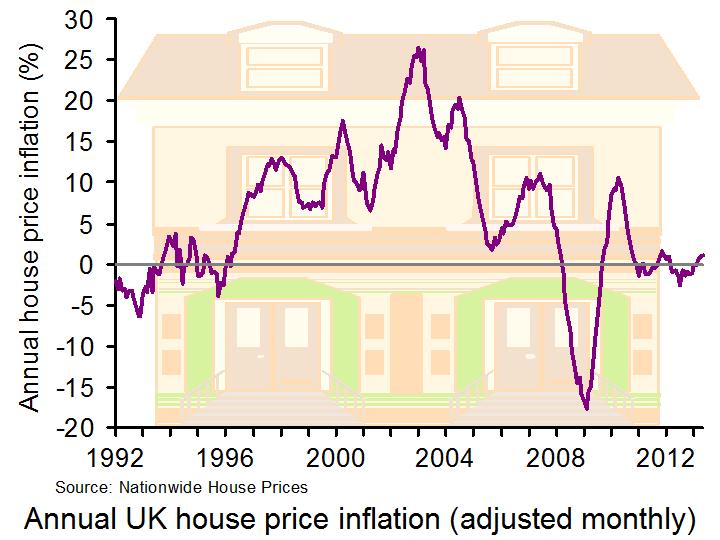 Which factors have contributed to this tentative recovery? Most households require a mortgage to purchase a house and, given the central role that the housing market played in the financial crisis with companies engaging in excessive lending as a means of expanding their mortgage books, the availability of mortgages fell. The number of mortgage approvals is likely to feed through to affect the number of house sales and these have improved in the first few months of 2013. Interest rates offered by lenders have also fallen, making mortgages more affordable, thus boosting demand. Furthermore, government assistance is available to help individuals put a deposit down on a house, by offering them an equity loan. Further measures are due to come into effect in January 2014, with the aim of providing a further boost to the housing market. The chief economist at Nationwide, Robert Gardner said:
Which factors have contributed to this tentative recovery? Most households require a mortgage to purchase a house and, given the central role that the housing market played in the financial crisis with companies engaging in excessive lending as a means of expanding their mortgage books, the availability of mortgages fell. The number of mortgage approvals is likely to feed through to affect the number of house sales and these have improved in the first few months of 2013. Interest rates offered by lenders have also fallen, making mortgages more affordable, thus boosting demand. Furthermore, government assistance is available to help individuals put a deposit down on a house, by offering them an equity loan. Further measures are due to come into effect in January 2014, with the aim of providing a further boost to the housing market. The chief economist at Nationwide, Robert Gardner said:
Widespread expectations that the economy will continue to recover gradually in the quarters ahead, that interest rates will remain low, and the ongoing impact of policy measures aimed at supporting the availability and lowering the cost of credit all provide reasons for optimism that activity will continue to gain momentum in the quarters ahead.
Despite the optimism, the situation is different across the UK, with some areas benefiting more than others. London and the South-East are driving this 0.4% rise, whereas other areas may be in need of further assistance to keep pace (see The UK housing market: good in parts).
Although these latest data may be a sign of things to come, it is also possible that things could go the opposite way. Incomes remain low; employment data are hardly encouraging; and the spectre of inflation is always there. Perhaps most importantly, consumer confidence remains fragile and until that gains momentum, uncertainty will continue to plague the UK marketplace. The following articles consider this issue.
Articles
UK house prices again up in May, says Nationwide The Guardian, Hilary Osborne (30/5/13)
Housing market could boost retail industry, Kingfisher says The Telegraph, Graham Ruddick (30/5/13)
UK house prices see modest rise, says Nationwide BBC News (30/5/13)
 Hugh’s Review: House prices in spotlight BBC News, Hugh Pym with Yolande Barnes of Savills and Matthew Pointon of Capital Economics (31/5/13)
Hugh’s Review: House prices in spotlight BBC News, Hugh Pym with Yolande Barnes of Savills and Matthew Pointon of Capital Economics (31/5/13)
House prices are racing ahead as stimulus for the market kicks in Independent, Russell Lynch (31/5/13)
’Pick up’ in house prices recorded in sign of market confidence, says Nationwide Independent, Vicky Shaw (30/5/13)
House prices at highest level for nearly two years as confidence in UK economy grows and mortgages get cheaper This is Money, Matt West (30/5/13)
Stamp duty is ‘choking’ housing market as it rises seven times faster than inflation over last 15 years Mail Online, Tara Brady (28/5/13)
Nationwide launches Help to Buy mortgages The Telegraph, William Clarke (29/5/13)
UK home prices rise most in 18 months, Nationwide says Bloomberg, Jennifer Ryan (30/5/13)
House price data
Links to house price data The Economics Network
Statistical data set – Property transactions Department of Communities and Local Government
Nationwide house price index Nationwide Building Society
Halifax House Price Index Lloyds Banking Group
Lending to individuals – November 2012 Bank of England
Questions
- How is the equilibrium determined in the housing market? Using a demand and supply diagram, illustrate the equilibrium. Make sure you think about the shapes of the curves you’re drawing.
- Which factors affect the demand for and supply of housing?
- Why are there regional variations in house prices?
- Why is the housing market a good indicator of the strength of the economy?
- Why have house prices risen throughout 2013? Is the trend likely to continue?
- If the housing market does indeed gain momentum, how might this affect the rest of the economy? Which sectors in particular are likely to benefit?
- Explain why the government’s intervention in the housing market could be seen to have a multiplier effect?
- Concerns have been raised that the government’s schemes to help the housing market may create a house price bubble. Why might this be the case?
 When you are next in town shopping, just keep in mind that consumer spending accounts for a little over 60 per cent of GDP. Therefore, consumption is incredibly important to the economy. How consumers behave is crucial to our short-term economic growth. The second estimate of British growth from the Office for National Statistics shows that the economy expanded by 0.3 per cent in the first three months of 2013. This follows a 0.3 per cent decline in the final quarter of 2012. Real household expenditure rose by just 0.1 per cent in Q1 2013. However, this was the sixth consecutive quarter in which the volume of purchases by households has grown.
When you are next in town shopping, just keep in mind that consumer spending accounts for a little over 60 per cent of GDP. Therefore, consumption is incredibly important to the economy. How consumers behave is crucial to our short-term economic growth. The second estimate of British growth from the Office for National Statistics shows that the economy expanded by 0.3 per cent in the first three months of 2013. This follows a 0.3 per cent decline in the final quarter of 2012. Real household expenditure rose by just 0.1 per cent in Q1 2013. However, this was the sixth consecutive quarter in which the volume of purchases by households has grown.
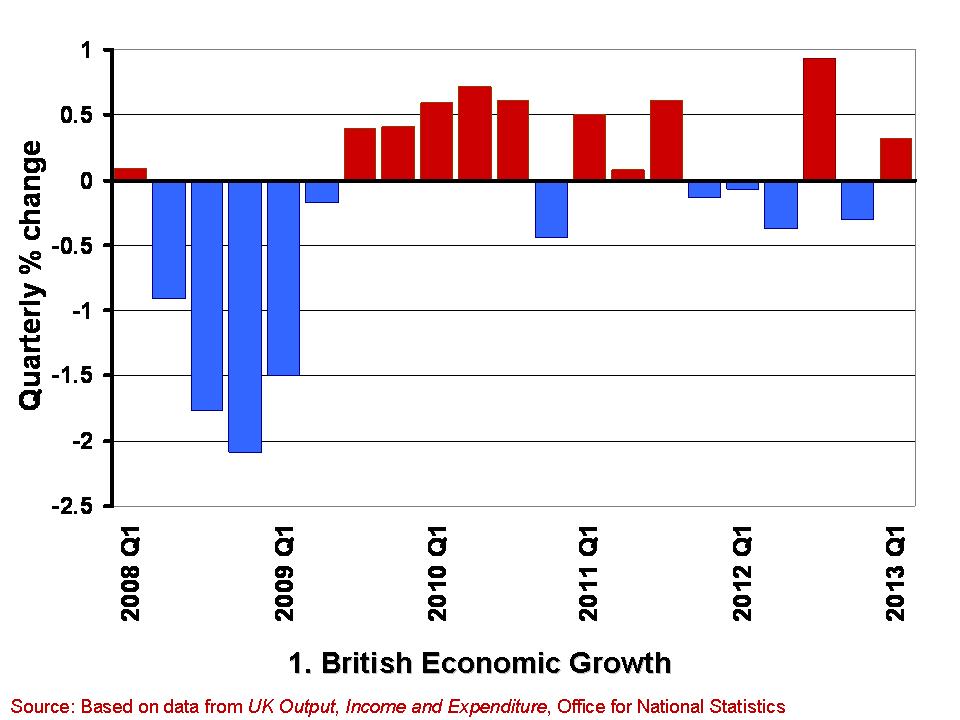 The growth in the economy is measured by changes in real GDP. Chart 1 shows the quarter-to-quarter change in real GDP since Q1 2008. (Click here to download a PowerPoint of the chart). During this period the economy is thought to have contracted in 10 of the 21 quarters shown. Furthermore, they show a double-dip recession and so two periods in close proximity where output shrank for two or more quarters. While more recent output numbers are frequently revised, which could see the double-dip recession possibly ‘statistically wiped’ from history, the period since 2008 will always been one characterised by anemic growth. The average quarterly growth rate since Q1 2008 has been -0.12 per cent.
The growth in the economy is measured by changes in real GDP. Chart 1 shows the quarter-to-quarter change in real GDP since Q1 2008. (Click here to download a PowerPoint of the chart). During this period the economy is thought to have contracted in 10 of the 21 quarters shown. Furthermore, they show a double-dip recession and so two periods in close proximity where output shrank for two or more quarters. While more recent output numbers are frequently revised, which could see the double-dip recession possibly ‘statistically wiped’ from history, the period since 2008 will always been one characterised by anemic growth. The average quarterly growth rate since Q1 2008 has been -0.12 per cent.
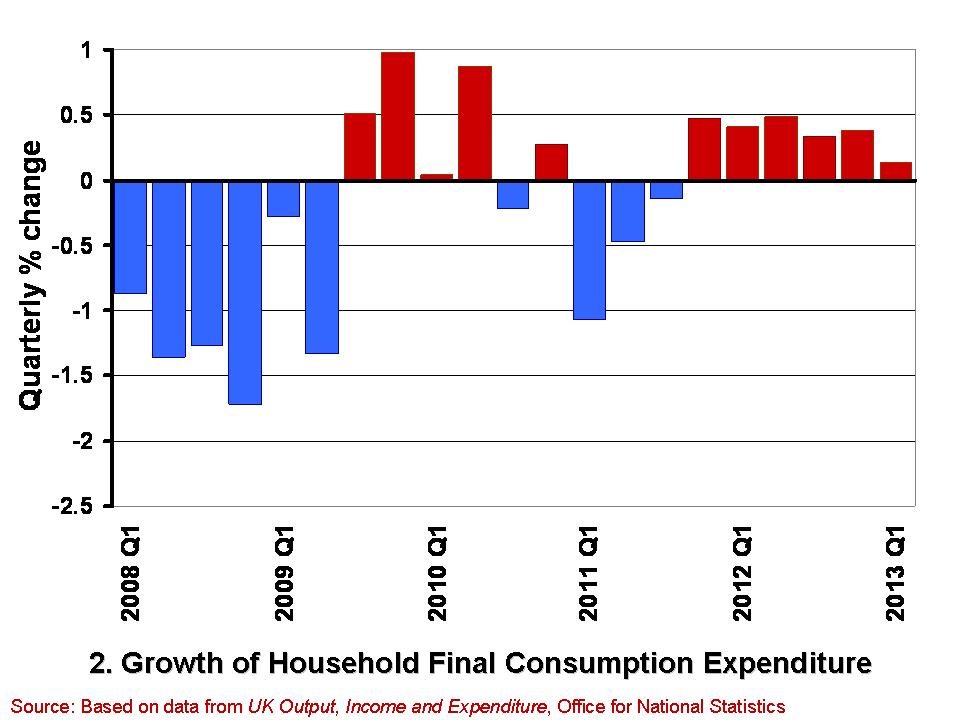 Chart 2 shows from Q1 2008 the quarterly growth in household expenditure in real terms, i.e. after stripping the effect of consumer price inflation. (Click here for a PowerPoint of the chart). Over the period, the volume of household consumption has typically fallen by 0.18 per cent per quarter. Hence, consumption has feared a little worse than the economy has a whole.
Chart 2 shows from Q1 2008 the quarterly growth in household expenditure in real terms, i.e. after stripping the effect of consumer price inflation. (Click here for a PowerPoint of the chart). Over the period, the volume of household consumption has typically fallen by 0.18 per cent per quarter. Hence, consumption has feared a little worse than the economy has a whole.
While the annualised rate of growth for the economy since Q1 2008 has averaged -0.47 per cent that for consumer spending has averaged -0.73 per cent. However, these figures disguise a recent improvement in consumer spending growth. This is because the volume of consumption has in fact grown in each of the six quarters since Q4 2011. In contrast, the economy has grown in only 2 of these quarters. It is, of course, much too early to start trumpeting consumption growth has heralding better times, not least because the 0.1 per cent growth in Q1 2013 is the weakest number since positive consumption growth resumed at the back end of 2011. Nonetheless, the figures do deserve some analysis by economists to understand what is going on.
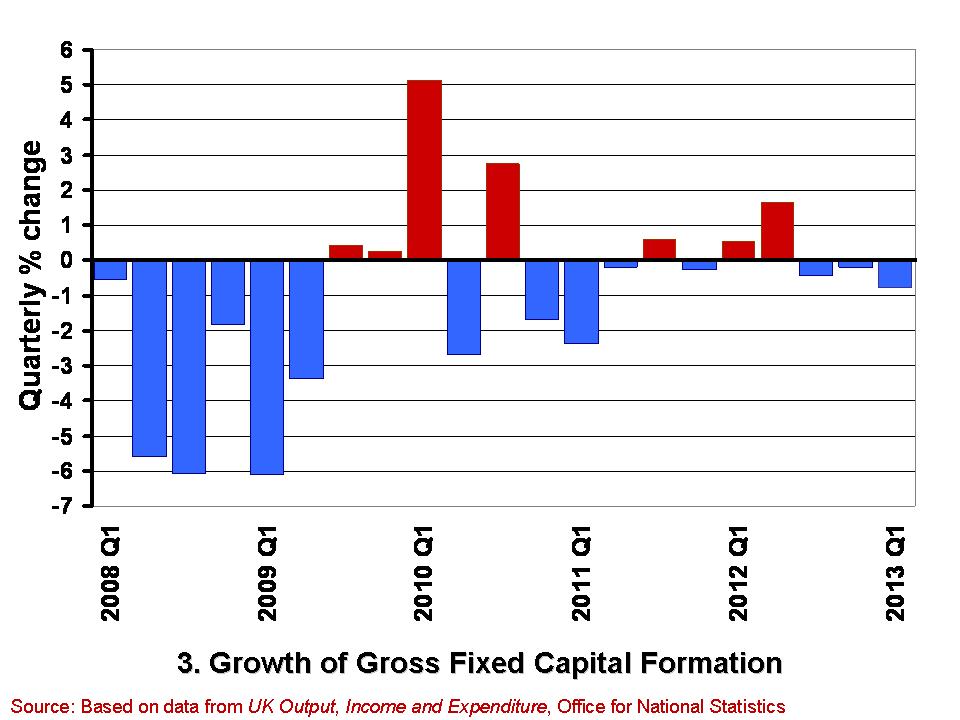 A slightly less promising note is struck by the gross fixed capital formation (GFCF) numbers. These numbers relate to the volume of investment in non-financial fixed assets, such as machinery, buildings, office space and fixtures and fittings. Chart 3 shows the quarterly growth in the volume of GFCF since Q1 2008. (Click here for a PowerPoint of the chart). The average quarterly rate of growth over this period has been -0.77 per cent. This is equivalent to an annual rate of decline of 3.9 per cent. GFCF has risen in only 7 of these quarters, declining in the remaining 14 quarters.
A slightly less promising note is struck by the gross fixed capital formation (GFCF) numbers. These numbers relate to the volume of investment in non-financial fixed assets, such as machinery, buildings, office space and fixtures and fittings. Chart 3 shows the quarterly growth in the volume of GFCF since Q1 2008. (Click here for a PowerPoint of the chart). The average quarterly rate of growth over this period has been -0.77 per cent. This is equivalent to an annual rate of decline of 3.9 per cent. GFCF has risen in only 7 of these quarters, declining in the remaining 14 quarters.
Worryingly, gross fixed capital formation has decreased in each of the last three quarters. While these figures may reflect continuing difficulties encountered by businesses in obtaining finance, they may also point to lingering concerns within the business community about the prospects for sustained growth. Therefore, it is important for economists to try and understand the drivers of these disappointing investment numbers and, hence, whether it is these or the slightly better consumption numbers that best hint at our short-term economic prospects.
Data
Second estimate of GDP, Q1 2013 Office for National Statistics
Second Estimate of GDP, Q1 2013 Dataset Office for National Statistics
Articles
UK GDP: concerns about underlying economy as 0.3pc growth confirmed Telegraph, Philip Aldrick (23/5/13)
UK investment fall among worst in G8 Guardian, Phillip Inman (23/5/13)
UK first-quarter growth unchanged BBC News (28/5/13)
U.K. Economy Grows 0.3% on Inventories, Consumer Spending Bloomberg, Svenja O’Donnell (23/5/13)
Surge in consumer spending kept UK out of recession The Telegraph (28/5/13)
Boost in service sector activity The Herald, Greig Cameron (28/5/13)
Hopes dashed as household spending rises by just 0.1% The Herald, Ian McConnell (24/5/13)
Questions
- Why do we typically focus on real GDP rather than nominal GDP when analysing economic growth?
- What is meant by aggregate demand? Of what importance is consumer spending to aggregate demand?
- Why might the patterns we observe in consumer spending differ from those in other components of aggregate demand?
- What factors might influence the determination of consumer spending?
- What do you understand by gross fixed capital formation? What factors might help to explain how its level is determined?
- Of what significance is gross fixed capital formation for aggregate demand and for aggregate supply?
- What is a recession? What is a double-dip recession?
- What data would you need to collect to identify a recession?
 In the blog The global economy we considered the economic performance of countries across the globe, including the UK. In the first estimate of UK economic growth for the first quarter of 2013, the economy grew at 0.3%, thus avoiding a triple-dip recession. This first estimate is always subject to change, but in this case, the data was confirmed.
In the blog The global economy we considered the economic performance of countries across the globe, including the UK. In the first estimate of UK economic growth for the first quarter of 2013, the economy grew at 0.3%, thus avoiding a triple-dip recession. This first estimate is always subject to change, but in this case, the data was confirmed.
The April 2013 figure provided by the ONS of 0.3% growth has been confirmed, once again indicating the slow recovery of the UK economy. Despite these more positive signs for the economy, the IMF has raised concerns of the weak performance of the UK and has urged the government to invest more in projects to stimulate growth. Although the economy has started to grow, economic growth has continued to remain weak since the onset of the financial crisis and recession. Martin Beck, an economist at Capital Economics said:
With employment and average earnings both dropping in the first quarter on their level in the previous quarter, the foundations for a sustained recovery, even one driven by consumers, still look pretty rickety.
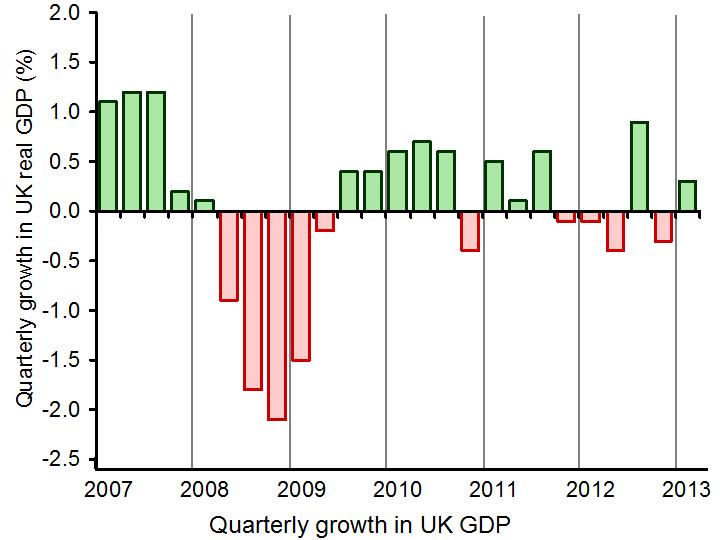 Initial estimates by the ONS are always updated and there is still time for the 0.3% growth figure to be changed, as more data becomes available. (Click here for a PowerPoint of the chart.) This latest figure, although unchanged, has given a more concrete indication of where the UK economy is continuing to struggle. Consumer spending increased by only 0.1%, investment and exports declined, but in further signs of a weak economy, the building up of stocks by companies was a big contributor to the UK economic growth – a contribution of 0.4 percentage points. The service sector continued to growth with a 0.6 percentage point contribution to GDP.
Initial estimates by the ONS are always updated and there is still time for the 0.3% growth figure to be changed, as more data becomes available. (Click here for a PowerPoint of the chart.) This latest figure, although unchanged, has given a more concrete indication of where the UK economy is continuing to struggle. Consumer spending increased by only 0.1%, investment and exports declined, but in further signs of a weak economy, the building up of stocks by companies was a big contributor to the UK economic growth – a contribution of 0.4 percentage points. The service sector continued to growth with a 0.6 percentage point contribution to GDP.
So, what does the future look like for the UK? Although the estimate of 0.3% figure did prevent a triple-dip recession and the IMF did comment on the ‘improving health’ of the economy, signs of recovery remain weak.
 Crucial to the recovery will be government spending, but more than this, the government spending must be in key growth industries. Data suggests that the UK invests less than other G8 countries as a percentage of GDP and this is perhaps one of the key factors that has prevented the UK recovery from gathering pace. The future of the UK economy remains uncertain and government policy will be crucial in determining this future course. The following articles consider the latest growth data.
Crucial to the recovery will be government spending, but more than this, the government spending must be in key growth industries. Data suggests that the UK invests less than other G8 countries as a percentage of GDP and this is perhaps one of the key factors that has prevented the UK recovery from gathering pace. The future of the UK economy remains uncertain and government policy will be crucial in determining this future course. The following articles consider the latest growth data.
Signs of weakness mar UK economic growth Reuters, Olesya Dmitracova and William Schomberg (23/5/13)
UK first quarter growth unchanged BBC News (23/5/13)
Concerns over underlying health of UK economy as 0.3% growth confirmed The Guardian, Philip Inman (23/5/13)
Statisticians confirm 0.3% UK growth for first quarter of 2013 Financial Times, Claire Jones and Sarah O’Connor (23/5/13)
UK GDP: concerns about underlying economy as 0.3pc growth confirmed The Telegraph, Philip Aldrick (23/5/13)
Britsh economy returns to growth in first quarter The Economic Times (23/5/13)
U.K. households not loosening purse strings Wall Street Journal, Ainsley Thomson and Ilona Bllington (23/5/13)
 IMF: UK should push for economic growth BBC News (22/5/13)
IMF: UK should push for economic growth BBC News (22/5/13)
Questions
- Why are numerous estimates of GDP made by the ONS?
- How is GDP measured? Is it an accurate measure of economic growth? What about economic development?
- Why does 0.3% growth in the first quarter of GDP not necessarily imply that the UK economy is recovering?
- Why have certain aspects of the UK economy performed better or worse than others?
- What areas should the government invest in, according to the IMF?
- Why would government spending in investment create economic growth? Is this likely to be short term or long term?
 There’s some good news and some bad news about the UK economy. The good news is that there are signs that the recovery is gathering momentum; the ‘green shoots’ are growing bigger. The bad news is that it’s the ‘wrong type of growth’!
There’s some good news and some bad news about the UK economy. The good news is that there are signs that the recovery is gathering momentum; the ‘green shoots’ are growing bigger. The bad news is that it’s the ‘wrong type of growth’!  But also, despite the austerity policies, the economy has not been ‘rebalanced’ towards exports and investment. Exports are 3% lower than in 2006 (although they did grow between 2009 Q2 and 2011 Q1, but have since stagnated). And investment is 27% lower than in 2006. Household consumption, however, has grown by about 2% and general government consumption by around 9% since 2006. The chart shows the figures, based on 2006 Q1 = 100.
But also, despite the austerity policies, the economy has not been ‘rebalanced’ towards exports and investment. Exports are 3% lower than in 2006 (although they did grow between 2009 Q2 and 2011 Q1, but have since stagnated). And investment is 27% lower than in 2006. Household consumption, however, has grown by about 2% and general government consumption by around 9% since 2006. The chart shows the figures, based on 2006 Q1 = 100. Britain’s imbalanced economy The Economist, Zanny Minton Beddoes and Richard Davies (4/7/13)
Britain’s imbalanced economy The Economist, Zanny Minton Beddoes and Richard Davies (4/7/13) Britain’s Export Drought: an enduring disappointment The Economist, Andrew Palmer and Richard Davies (9/2/13)
Britain’s Export Drought: an enduring disappointment The Economist, Andrew Palmer and Richard Davies (9/2/13) ‘Green shoots’ of economic recovery in Rugby BBC News, Paul Mason (12/6/13)
‘Green shoots’ of economic recovery in Rugby BBC News, Paul Mason (12/6/13)










